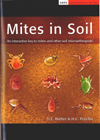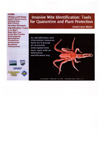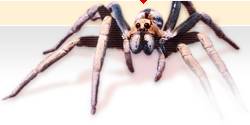
Identification of Mites (Acari)
(compiled by Bruce Halliday)
A number of resources allow the identification of mites in the Australasian region:
 |
Mites in Soil by D.E. Walter and H.C. Proctor Australian Biological Resources Survey, 2001, CD-ROM, ISBN 0 643 06790 6 Mites in Soil contains five interactive keys for the identification of 101 families of soil mites and more than 60 higher taxa of other groups of soil invertebrates, such as Onychophora and tardigrades. The keys are profusely illustrated with line drawings, photos, and scanning electron micrographs. They are mainly intended to deal with the Australian fauna, but can also be used on a world-wide scale. The CD also contains information on morphology and biology of mites, methods of collecting and preservation, and how to study living mites. It is suitable for use by both experienced acarologists and non-specialists interested in soil biology. |
 |
Oribatid Mites CD-Rom Oribatid Mites: An Interactive Glossary of Oribatid Mites by G.S. Hunt, R.A. Norton, J.P.H. Kelly, M.J. Colloff and S.M. Lindsay An Interactive Key to Oribatid Mites of Australia by G. S. Hunt, M.J. Colloff, M.J. Dallwitz and D.E. Walter CSIRO Publishing, 1998, CD-ROM and 28 page user guide, ISBN 0 643 06369 2 Oribatid mites feed on decaying plant material and on fungi and bacteria. In doing so they play a valuable role in nutrient cycling and improvement of soil structure. This CD contains two significant works on this important group of mites. First, there is an interactive glossary that explains the terminology used in the classification of oribatid mites. Hundreds of morphological terms are defined and illustrated, with support from literature references. Then there is an interactive key for the identification of 80 families, 160 genera and 380 species of oribatids that occur in Australia. This will be an essential reference for soil scientists, ecologists, and all others with an interest in oribatids. |
 |
Invasive Mite Identification: Tools for Quarantine and Plant Protection by D.E. Walter, 2006 Mites are tiny, highly diverse, omnipresent in crops, soil, timber products, warehouses and other human habitations, and on animals, and present a major challenge to quarantine. Even innocuous mites can be difficult to identify with a level of certainty that will allow for prompt regulatory decisions. This site provides nine interactive tools that can be used to help in the identification of mites that could be intercepted in quarantine. The keys are designed to provide support to quarantine workers at three levels: training in mite anatomy and identification, preliminary identification and advanced taxonomic support. The keys range in complexity from Is it a mite?, at a very basic introductory level, to species level treatments (e.g., Stratiolaelaps). An illustrated glossary with more than 700 acarological terms defined is also provided. The keys will be very valuable for use in identification of mites in general, aside from their use in quarantine. |
 |
The Australian Water Mites: A Guide to Families and Genera by M.S. Harvey, 1998 Water mites are a dominant feature of the fauna of all freshwater ecosystems. Over 400 species in 87 genera and 22 families have been recorded in Australia. This book consists of illustrated keys to each family and genus. There are sections on cladistic analysis and classification, biogeographic affinities of the Australian fauna, general biology and morphology. |

